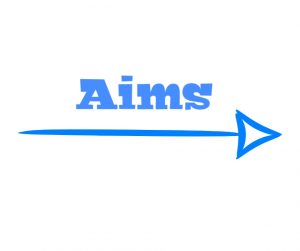Differences between aims and objectives: Although they are frequently used interchangeably, objectives and objectives serve entirely different purposes. To fulfill one’s ambition or realize their dream, one needs to have both of these things. They can be utilized to achieve any professional or personal goal. According to Michelle Obama, “The only limit to the height of your achievements is the reach of your aspirations and your desire to fight for them.” This proverb does a great job of explaining why it’s important objectives and aims in life. People frequently fail to see their differences from one another, especially when viewed from the perspective of a “business tagline.”
Whether it be a personal aim or a professional one. Aim serves as the reason for a project. It is the main factor that drives people to work hard and improve. Not only is it the first step in a project’s journey, but it also represents the overarching goal that each person has for their project. Objectives are the different actions that are taken as part of a bigger plan to accomplish the goal that has been established by the individual or group of individuals. People may have personal objectives, personal objectives, or perhaps both. They frequently outnumber aims in terms of number. Let’s look more closely at the difference between aim and objective in this post.
Recommended: Advantages and Disadvantages of Delegated Legislation
What is an Aim?
The general expression of the desired result is the aim. An aim is a vision of the future or desired outcome that a person or group of people commits to achieving. The desired result impresses you or directs your planned course of action. It is a goal or desire that one directs their efforts toward. It is the process of focusing on something at or at a specific place or object.

Your aim can stop you from relaxing. The aim is to do something that increases a person’s value from zero to infinite. The preparation of a goal that a person wishes to accomplish is the aim. The term of an aim can be long, average, or short. The time needed to do them is the key distinction. Aims have the following effects.:
1. Goal-relevant activities receive attention and effort via aims.
2. Bigger aims require more work.
3. Effort is prolonged by challenging goals, but tenacity is increased by aims.
4. Aims ultimately result in understanding, the use of task-relevant information and techniques, and their discovery. Success in any area requires a willingness to reject justifications for inadequate work or inadequate planning. The likelihood that someone will believe they can accomplish an aim also has an impact on that success. aims to serve as a fundamental guide for carrying out a project or performing research. It has a long-term outlook that reflects the entity’s ambitions and aspirations.

Recommended: Most Expensive Watches in The World and Their Prices
What is an Objective?
An objective is a specified result reached within a time frame and with the available resources. The steps taken to accomplish an organization’s long-term goals are called objectives. The corporation’s objectives serve as guidance for its staff regarding what they must do to produce the intended outcome. They come in the form of brief statements that describe what you desire and are employed in a variety of situations. The main tools used in all planning and strategic operations are objectives.

They serve as the foundation for formulating policy and assigning performance levels. Business objectives can include things like cutting costs, becoming global or turning a profit.
The term “objective” refers to a method that is solely based on factual information and the rejection of subjective viewpoints. Real certainty is prioritized over subjective judgments based on one’s expectations or feelings. It exists without regard to the perception or the ideas of an individual.
Also see: Advantages and Disadvantages of Being an Entrepreneur
An objective is a (relatively) short-term goal that successful students will complete within the parameters of the actual course. In course materials, objectives are frequently stated in a way that clarifies to students what they should aim to accomplish while learning. All outlining and strategic actions are based on the fundamental instruments known as objectives. To make it simple to see the project’s essential steps, these are typically omitted in favor of a numbered list. There are other characteristics of objectives that are also known as SMART, including:
1. Specific: When putting up an objective, one must be extremely specific and must prevent any ambiguity that may get in the way.
2. Measurable: Objectives should be achievable and measurable in some way. Consequently, a corporation should set a target that is defined in units if it wants to boost sales.
3. Agreed on; The objective must be accepted by everyone who will contribute to realizing it.
4. Realistic: People frequently make objectives based on what they want to accomplish even though they lack the necessary resources. As a result, when choosing an objective, one must take into account available resources as well as any potential constraints.
5. Time-Bound: Ensure that the objectives you intend to accomplish have a deadline.

Recommended: How to Know Gods Plan for your life
Major Differences Between Aims and Objectives
1. The ultimate goal that a person or an organization strives to achieve is characterized by the phrase aim. The objective is anything that a person or other entity pursues relentlessly.
2. The entity’s objectives show its short-term goals, whereas its aim indicates its long-term achievements.
3. The term “objective” describes the ultimate strategies of a person or organization. The aim, on the other hand, is a person’s or a business’s precise goal.
4. As opposed to objectives, which are focused on the company’s accomplishments, aims are tied to the mission and purpose of the organization.
Also see: How to Know an Introvert: 11 Signs You are One
5. The aim clarifies what is intended to be accomplished. While an objective, which explains how something is to be accomplished?
6. Since it is difficult to predict with accuracy how long something will take to accomplish, aims are not time-bound, i.e. there is no deadline within which the organization must fulfill its aim. On the other hand, objectives usually come with a deadline by which they must be accomplished.
7. An objective is constantly as definite as it can be, unlike an aim, which is sometimes thought of as being a little ambiguous. While objectives are precise, goals are general. Last but not least, there is a distinction between the two in terms of measurability: aims cannot be measured, whereas objectives can be measured.
Recommended: How to Become a Better Singer Fast: 8 Tips to Improve Your Voice
Conclusion
In conclusion, even though individuals frequently use them interchangeably, they are not the same. The words “Aims” and “Objectives” all point in the same direction and can be combined to accomplish the same goal. Aims and objectives are both necessary to reach the goal that a person or group has set.
It would not be possible to shoot the target and hit the target’s or the target’s vision if there was only one of either of them. Although the two terms are synonyms, the actual concepts are distinct. The goals and objectives should not just be theoretical but also realistic. The major reason that an Idea or Project may be realized is because of them.

Edeh Samuel Chukwuemeka, ACMC, is a lawyer and a certified mediator/conciliator in Nigeria. He is also a developer with knowledge in various programming languages. Samuel is determined to leverage his skills in technology, SEO, and legal practice to revolutionize the legal profession worldwide by creating web and mobile applications that simplify legal research. Sam is also passionate about educating and providing valuable information to people.